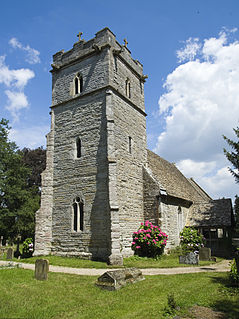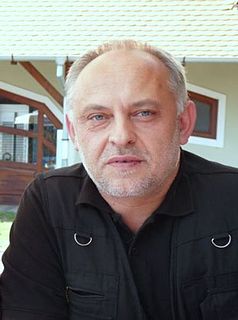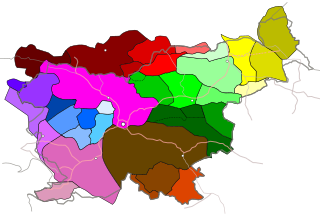| Dolenci Dolány | |
|---|---|
| Coordinates: 46°51′4.43″N16°17′15.45″E / 46.8512306°N 16.2876250°E Coordinates: 46°51′4.43″N16°17′15.45″E / 46.8512306°N 16.2876250°E | |
| Country | |
| Traditional region | Prekmurje |
| Statistical region | Mura |
| Municipality | Šalovci |
| Area | |
| • Total | 7.72 km2 (2.98 sq mi) |
| Elevation | 302.1 m (991.1 ft) |
| Population (2002) | |
| • Total | 206 |
| [1] | |
Dolenci (pronounced [dɔˈleːntsi] ; Hungarian : Dolány [2] ) is a village in the Municipality of Šalovci in the Prekmurje region of Slovenia, on the border with Hungary. [3]

Hungarian is a Finno-Ugric language spoken in Hungary and several neighbouring countries. It is the official language of Hungary and one of the 24 official languages of the European Union. Outside Hungary it is also spoken by communities of Hungarians in the countries that today make up Slovakia, western Ukraine (Subcarpathia), central and western Romania (Transylvania), northern Serbia (Vojvodina), northern Croatia, and northern Slovenia. It is also spoken by Hungarian diaspora communities worldwide, especially in North America and Israel. Like Finnish and Estonian, Hungarian belongs to the Uralic language family. With 13 million speakers, it is its largest member in terms of speakers.

Šalovci is a village and a municipality in the Prekmurje region in northeastern Slovenia.

Prekmurje is a geographically, linguistically, culturally and ethnically defined region settled by Slovenes and a Hungarian minority, lying between the Mur River in Slovenia and the Rába Valley in the most western part of Hungary. It maintains certain specific linguistic, cultural and religious features that differentiate it from other Slovenian traditional regions. It covers an area of 938 km2 and has a population of 78,000 people.
Contents
The parish church in the settlement is dedicated to Saint Nicholas and belongs to the Murska Sobota Diocese. The original parts of the church date to 1331, but it was expanded in the 16th century and in the late 18th century. It has a rectangular nave with a Gothic sanctuary and a belfry on its western facade. [4]

A parish church in Christianity is the church which acts as the religious centre of a parish. In many parts of the world, especially in rural areas, the parish church may play a significant role in community activities, often allowing its premises to be used for non-religious community events. The church building reflects this status, and there is considerable variety in the size and style of parish churches. Many villages in Europe have churches that date back to the Middle Ages, but all periods of architecture are represented.

Saint Nicholas of Myra, also known as Nicholas of Bari, was an early Christian bishop of the ancient Greek maritime city of Myra in Asia Minor during the time of the Roman Empire. He is revered by many Christians as a saint. Because of the many miracles attributed to his intercession, he is also known as Nicholas the Wonderworker. Saint Nicholas is the patron saint of sailors, merchants, archers, repentant thieves, children, brewers, pawnbrokers, and students in various cities and countries around Europe. His reputation evolved among the faithful, as was common for early Christian saints, and his legendary habit of secret gift-giving gave rise to the traditional model of Santa Claus through Sinterklaas.

The Roman Catholic Diocese of Murska Sobota is a diocese located in the city of Murska Sobota in the Ecclesiastical province of Maribor in Slovenia.












